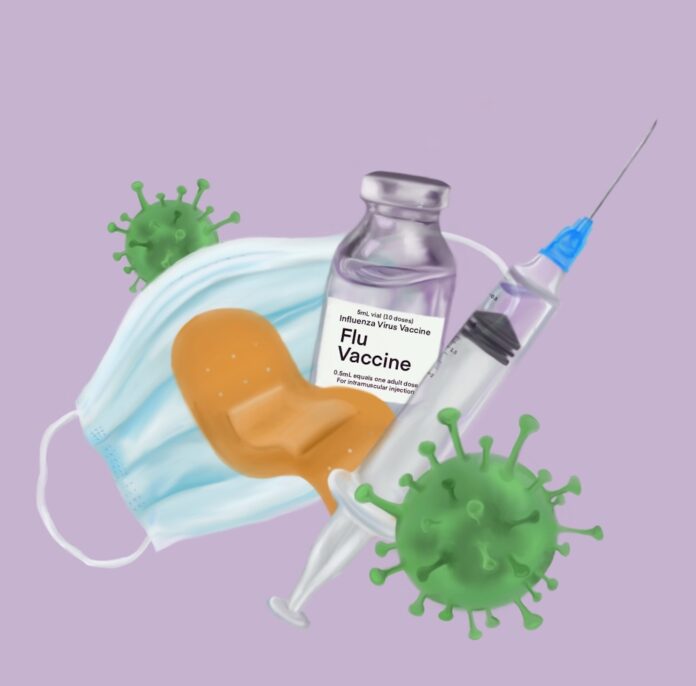The approaching flu season and the recent spike in U.S. COVID-19 cases have raised concerns about the interaction between the flu and COVID-19. In preparation for flu season on campus, the college is providing and covering the costs of flu shots and continuing to observe COVID-19 precautions, according to Sara Semal, senior director of student wellness and special advisor to the president on health and safety. Semal said Emmons Wellness Center is also providing telemedical and in-person care and consultation, as well as masks and hand sanitizer. Jessica Dirkes, professor of public health and co-chair of the public health program at Occidental, said there are public health worries about the risk of being infected with both at once or that an increase of flu cases could overwhelm health care systems.
According to Evelyn Chan, nurse practitioner at Emmons Wellness Center, the Los Angeles Department of Public Health (LADPH) has mandated that all students living on campus and college employees receive a flu shot due to the increased risk of infection associated with communal living. According to an email from Semal, the college hosted four flu clinics where students, staff and faculty could receive their flu shot. Although the official Emmons flu clinics are over, Chan said students and employees can still schedule an appointment through Emmons to come in and get their flu shot.
Chan said there is a common misconception that it might be too late to get a flu shot after September or October and that it is actually effective to get immunized through January or February since flu season can continue until May.
“I feel like it’s a little thing that you can do that will protect you for the season and that way just decreases your risk of getting the flu and decreases … risks of complications,” Chan said. “It’s definitely a good thing to do for your community and to help protect others as well.”
Dirkes said she echoed this sentiment and encourages everyone to get immunized against the flu as a way to protect themselves and others.
“I’ve always been a big advocate of the flu vaccine and I’m always surprised how few people get it. … It’s one of the great successes of public health, and that we can vaccinate people against diseases and it’s protective and safe,” Dirkes said. “We’re dealing with an unknown illness and we don’t have a vaccine yet for it … so take the ones that we have so that we can focus our resources and our effort on getting through this.”
According to Semal, while the flu shot cannot fully guarantee you will not get the flu, it does greatly reduce your chance of contracting the virus, and if you do get it, the vaccine will reduce the severity of the illness.
Flu clinics are a normal occurrence every year at the college, Semal said, but this year they were conducted via appointment to avoid crowds. Semal also said students can receive flu immunization when they go in for COVID-19 testing. According to Semal, students who are vaccinated against the flu by the college will not be billed for the shot regardless of their insurance.
To help prevent the spread of the flu and of COVID-19, Chan said the college is also maintaining the public safety measures that have been in place due to COVID-19. According to Chan, this includes social distancing, continued use of masks and increased public hygiene procedures, like sanitation of public spaces. Chan also said the college has also focused on an intentional push in communicating important information surrounding the flu to students and employees.
According to Dirkes, the way COVID-19 and the flu may interact this year is still unknown since COVID-19 is a new virus and not fully understood yet; the interaction between the viruses in a person who is infected with both is also unclear.
“We’re entering into a time of a lot of unknowns,” Dirkes said. “They do know there is the possibility that somebody could be infected with both if they don’t get the flu vaccine and then the symptoms are the same. So it’s really concerning because … the severity of their illness is unclear on how those two infections would interact.”
Dirkes said that every year flu cases account for a large number of hospitalizations and doctor visits which may put stress on health care systems already dealing with COVID-19 cases and complications. Dirkes also said the similarities between the symptoms of both viruses can lead to difficulty in diagnosing and possibly overburden testing capacity.
According to Dirkes, she understands the desire to return to life before the pandemic, but right now the focus should be on preventative measures to keep yourself and those around you healthy and safe.
“We have to do everything we can to not overburden and overstrain our healthcare providers, our hospital systems and all the people on the frontlines who are doing the work of trying to treat people with this terrible disease,” Dirkes said. “It just makes the most sense to just keep yourself out of the system as much as possible.”
![]()



































